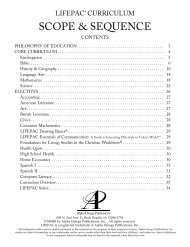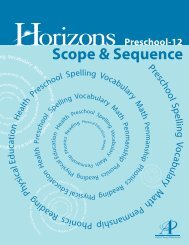Horizons Math Sampler - Odyssey Academy
Horizons Math Sampler - Odyssey Academy
Horizons Math Sampler - Odyssey Academy
You also want an ePaper? Increase the reach of your titles
YUMPU automatically turns print PDFs into web optimized ePapers that Google loves.
<strong>Horizons</strong> <strong>Math</strong> for Grades K-6<br />
<strong>Horizons</strong> <strong>Math</strong> provides a balanced and well-organized approach to primary math through<br />
analytical reasoning, manipulatives (hands-on learning), memorization and drill. Every concept, from<br />
addition and subtraction to graphs and estimation, follows a deliberate pattern of introduction and<br />
gradual development to ensure student success. Fundamental concepts already learned in earlier<br />
units are reviewed in subsequent grade levels for true mastery. Every math concept follows a<br />
deliberate pattern of gradual development in each grade level, as well as throughout all seven grade<br />
levels.<br />
Analytical reasoning skills are used in making daily decisions. Beginning with the introduction of<br />
each concept, <strong>Horizons</strong> teaches these thinking skills to help students gain a complete understanding<br />
of the concept. Students begin to reason from the principles taught in <strong>Horizons</strong> lessons and apply<br />
them to real-life situations.<br />
Strands:<br />
Numbers, Order & Value: Begins with a strong emphasis on counting and continues with a<br />
development of number comparisons, rounding, estimating, order of operations, prime factorization,<br />
Roman numbers, scientific notation, base 2 numbers, and integers.<br />
Addition & Subtraction: Starts with adding and subtracting single digits numbers to another<br />
number and increases to six-digit by six-digit operations. Also includes addition and subtraction<br />
properties, making change, and adding and subtracting equations.<br />
Ratios, Measurement & Decimals: From a foundation in money, time, calendar, dimension and<br />
capacity the concepts progress to temperature, unit conversions, ratios, percentages and decimals.<br />
Fractions & Comparison: Concepts of tall, short, long, longer, larger and smaller are extended to<br />
parts of a whole and on to addition, subtraction, multiplication and division of mixed numbers.<br />
Equations, Colors & Geometry: Recognition of colors, shapes and direction lead to computations<br />
involving area, perimeter, volume and surface area. Geometric definitions of point, line, segment, and<br />
ray develop into geometric constructions with a compass and straightedge. Equations are<br />
manipulated by addition, subtraction, multiplication and division and are written for word problems.<br />
Graphs, Estimation & Solving: Counting images on a pictograph expands to bar graphs, line<br />
graphs and coordinate graphs. Rounding of numbers continues to estimating solutions and operations<br />
of solving problems. Finding the average of a list of numbers sets the stage for mean, mode, median<br />
and probability.<br />
Multiplication and Division: Learning the multiplication facts 1-10 continues with learning<br />
multiplication and division terms and properties, to multiplication problems of 5-digits and division<br />
problems with a 4-digit divisor.<br />
18








